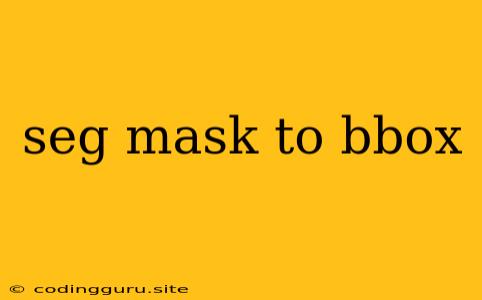Converting Segmentation Masks to Bounding Boxes: A Practical Guide
In computer vision, segmentation masks and bounding boxes are two fundamental tools for object detection and recognition. While they represent different aspects of the same object, they often work in tandem to provide a more comprehensive understanding of the image.
This article will guide you through the process of converting segmentation masks to bounding boxes, explaining the underlying logic and providing practical code examples. We'll explore why this conversion is useful and discuss different approaches to achieve it efficiently.
Why Convert Segmentation Masks to Bounding Boxes?
While segmentation masks provide a detailed outline of an object's pixels, bounding boxes offer a simpler and more compact representation. There are several reasons why converting segmentation masks to bounding boxes can be advantageous:
- Data efficiency: Bounding boxes require significantly less storage space compared to segmentation masks, making them ideal for large datasets.
- Speed: Object detection models trained on bounding boxes tend to be faster than those trained on segmentation masks.
- Compatibility: Many computer vision libraries and frameworks primarily work with bounding boxes, making this conversion necessary for interoperability.
Methods for Converting Segmentation Masks to Bounding Boxes
The core idea behind this conversion is identifying the minimum and maximum coordinates of the object within the segmentation mask. Here are the most common approaches:
1. Direct Pixel Iteration
The simplest method involves iterating through all pixels in the segmentation mask and finding the minimum and maximum x and y coordinates that correspond to object pixels. This approach, while straightforward, can be computationally expensive for large masks.
Python Code Example:
import numpy as np
def mask_to_bbox(mask):
rows = np.any(mask, axis=1)
cols = np.any(mask, axis=0)
ymin, ymax = np.where(rows)[0][[0, -1]]
xmin, xmax = np.where(cols)[0][[0, -1]]
return xmin, ymin, xmax, ymax
# Example usage
mask = np.array([[0, 0, 1, 1],
[0, 0, 1, 1],
[1, 1, 1, 1],
[1, 1, 1, 1]])
bbox = mask_to_bbox(mask)
print(bbox) # Output: (0, 0, 3, 3)
2. Using cv2.findContours()
For binary segmentation masks, OpenCV's cv2.findContours() function can efficiently find the contours of the object. The bounding rectangle of the largest contour can then be used as the bounding box.
Python Code Example:
import cv2
def mask_to_bbox(mask):
contours, hierarchy = cv2.findContours(mask, cv2.RETR_EXTERNAL, cv2.CHAIN_APPROX_SIMPLE)
if len(contours) > 0:
largest_contour = max(contours, key=cv2.contourArea)
x, y, w, h = cv2.boundingRect(largest_contour)
return x, y, x + w, y + h
else:
return None
# Example usage
mask = cv2.imread("path/to/mask.png", cv2.IMREAD_GRAYSCALE)
bbox = mask_to_bbox(mask)
print(bbox)
3. Using Image Processing Libraries
Libraries like scikit-image offer specialized functions for finding connected components within a mask, effectively extracting the objects and their bounding boxes.
Python Code Example using scikit-image:
from skimage import measure
def mask_to_bbox(mask):
labels = measure.label(mask)
props = measure.regionprops(labels)
if len(props) > 0:
bbox = props[0].bbox
return bbox[1], bbox[0], bbox[3], bbox[2] # Note: (ymin, xmin, ymax, xmax)
else:
return None
Choosing the Right Approach
The choice of conversion method depends on the specific requirements of your project. If computational speed is paramount, consider using cv2.findContours() for binary masks. For more complex segmentation masks with multiple objects, explore the functionalities offered by libraries like scikit-image.
Conclusion
Converting segmentation masks to bounding boxes is a common task in computer vision, offering advantages in terms of data efficiency, speed, and compatibility. By understanding the different methods and their trade-offs, you can choose the best approach to represent your objects effectively.
